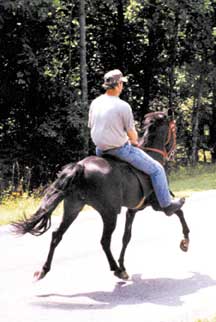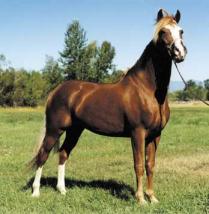
Return
to Breed Profiles Main Page North American Single-footing Horses - The Now and Forever BreedExcerpted from the North American Single-footing Horse Association "I
always did love a black horse and I had a beauty, a single-footer
named Defining a new breed from old, long sought after characteristics is an exciting prospect. The Single-Footing Horse is a light breed of good conformation, attractive in appearance and smooth riding.
The North American Single-Footing Horse Association (NASHA) was started in 1991 for ranch horses, pleasure and competition trail horses and versatility horses that travel with a true, old-style, single-footing gait. The goals of this registry were set by avid trail riders and ranchers who log thousands of miles per year on horseback under various conditions. Over and over again these riders requested the same qualities in a horse:
An intermediate,
four-beat gait At the fastest speeds the horse travels with one foot on the ground at a time. Some horses will start single-footing at a road gait speed and others at the racing speed. Either is correct. While the ideal horse will remain as close as possible to even timing at all speeds, at top speeds most horses tend toward a more lateral timing.
The medium length
of stride at most speeds goes with an athletic Since the gait is both even in timing and medium in stride, the horse will not exhibit a head nod. Most travel with head up. Many may stretch out and lower their heads at the racing single-foot. Trail riders also need a horse with adequate lift in front to clear uneven ground without stumbling. Lift comes naturally to this gait since the single-footing horse must get his front end out of the way of the driving rear end at speed. Difficulty establishing the breed The first step to establishing the breed was a search for quality foundation stock. Locating the few remaining pockets of horses with a true single-footing gait was not easy and many were very tightly line-bred. Horses were also found in the other gaited breeds where certain lines produced occasional single-footers (rather than the appropriate gait for their breed), from wild-horse herds and from non-gaited breeds where a gaited crop out still occurs. For several years any horse with an intermediate four-beat gait was eligible for registration. The registry is still open, but as of 1998 horses that running walk, fox trot, slick pace or have extremely long-striding gaits or short, tight-striding gaits are no longer accepted for registration. As of Jan. 1, 2000, only horses that are excellent examples of the true single-footing gait and of superior conformation will be accepted for registration. NASHA offers 45 categories for High Point awards only two of which, Road Gait and Park Gait are show ring classes. Road Gait is the premier gait class for Single-Footing Horses. The judge pushes the horses to see, if or at what point, the horse's gait breaks down. This checks for the strength of gait which is so essential in a good trail horse. The North American Single-footing Horse is well on its way to becoming a performance- based "breed" registry. Though Single-Footing Horses come in all sizes and colors, it is not surprising that a conformation type is emerging. We are starting to see a horse similar to the old-style Morgan with a slightly more refined neck. This is not surprising considering the original purpose for the Morgan Horse and the genetic types used in its development, such as the Narragansett Pacer and Spanish colonial horses. The North American Single-footing Horse differs from this type in that gait is of primary importance rather than something that occurred, but was not a requirement. For more information
contact: |
|||

 Peacock.
He could travel like the wind and had the best endurance I ever
saw in a horse. Everybody was trying to make a deal to get hold
of him. They even tried to win him as a stake in a gambling game.
I couldn't part with him, for we had been pals too long."
Peacock.
He could travel like the wind and had the best endurance I ever
saw in a horse. Everybody was trying to make a deal to get hold
of him. They even tried to win him as a stake in a gambling game.
I couldn't part with him, for we had been pals too long." conformation and ability, particularly regarding stock horse type
moves. The rear feet should at least cap (cover the print of the front
hoof), and will often overstride (land ahead of front foot track),
as speed increases. The length of stride also increases with
speed, keeping the horse smooth at various speeds. This requires a
powerful driving rear end. Both excessive rear hock action or a low
skating action that leads to tripping in the rear are avoided.
conformation and ability, particularly regarding stock horse type
moves. The rear feet should at least cap (cover the print of the front
hoof), and will often overstride (land ahead of front foot track),
as speed increases. The length of stride also increases with
speed, keeping the horse smooth at various speeds. This requires a
powerful driving rear end. Both excessive rear hock action or a low
skating action that leads to tripping in the rear are avoided.